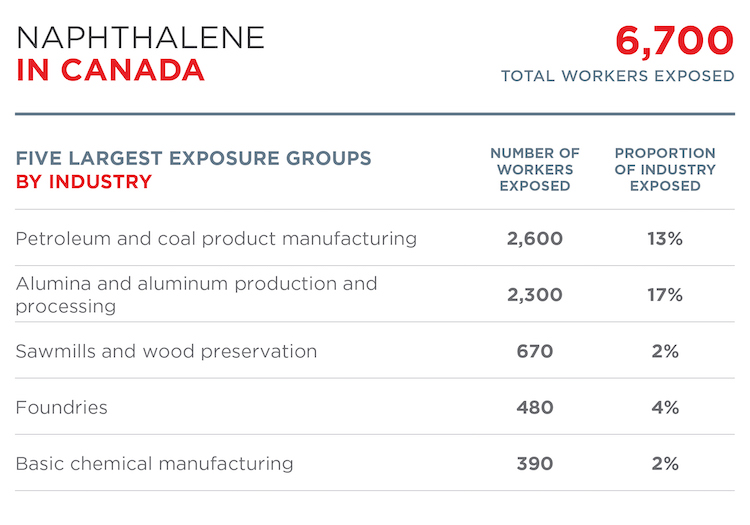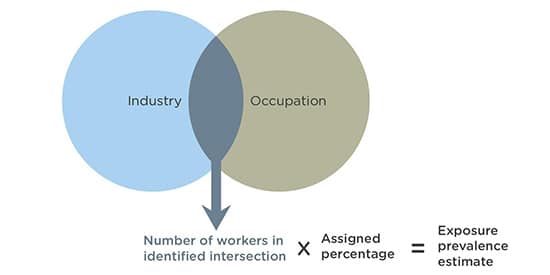Naphthalene Occupational Exposures
Naphthalene Occupational Exposures
READ MORE...
The largest industrial groups exposed are petroleum and coal products manufacturing, alumina and aluminum production and processing, and sawmills and wood preservation, foundries, and basic chemical manufacturing. Other industries that may be exposed to naphthalene include coal tar and coke industries, as well as construction industries (paving and roofing).[2]
The largest occupational groups exposed to naphthalene are machine operators in mineral and metal processing, central control and process operators in petroleum, gas and chemical processing, material handlers, and labourers in mineral and metal processing. Other workers may be exposed while producing mothballs, grinding wheels, and working with petroleum products, especially jet fuels.[2,3]
Prevalence Estimate
Results show that approximately 6,700 Canadians are exposed to naphthalene at work; 92% of these workers are male. Industries with the highest number of exposed workers are petroleum and coal products manufacturing (where pure naphthalene and coke are manufactured), alumina and aluminum production and processing (naphthalene emissions from graphite electrodes), and sawmills and wood preservation (where naphthalene is vapourized from creosote).
When exposure is examined by occupation, important occupational groups exposed machine operators in mineral and metal processing (1,400 workers exposed), central control and process operators in petroleum, gas and chemical processing (1,400 workers exposed), material handlers (640 workers exposed), and labourers in mineral and metal processing (480 workers exposed).
The number of workers exposed to naphthalene decreased by approximately 1,800 workers from 2006 to 2016 (a 21% decrease). This was driven by a decrease in the total number of workers in alumina manufacturing and foundries.
Workers exposed to naphthalene by industry in 2016

Workers exposed to naphthalene by region in 2016
Click the second tab to view total number of workers exposed.
* = < 50 workers
Methods and Data
Our Occupational Approach page outlines the general approach used to calculate prevalence and exposure level estimates for workplace exposures.
Data Sources
Data used in developing the occupational estimates for naphthalene were collected from several sources:
- The Canadian Workplace Exposure Database (CWED) contains approximately 200 measurements for naphthalene exposure. These measurements were collected during the years 1981 to 2004 in Ontario and British Columbia workplaces.
- Canadian and US scientific peer reviewed publications that addressed naphthalene exposure in Canada and the United States.
- Grey literature including technical reports from governments and international bodies.
Prevalence Estimate Method
CAREX defines exposure to naphthalene as inhalation exposure at work at levels exceeding those encountered in non-occupational settings, such as exposure due to inhaling urban air (i.e. from incomplete combustion) and/or indoor air (i.e. from mothballs). Naphthalene is a polycyclic aromatic hydrocarbon (PAH), but exposure here is intended to reflect industries and occupations where it occurs as an industrial product, rather than as a mixed product of incomplete combustion. Further information on PAHs can be found elsewhere on the CAREX Canada website.
To determine the number of workers potentially exposed to naphthalene at work, CAREX occupational exposure experts used methods previously established in other peer-reviewed CAREX projects in Europe. A series of steps were taken to assign exposure proportions to occupations and industries at risk of exposure to naphthalene.

- Occupations and industries at risk of possible exposure to naphthalene were identified using any combination of data sources described above.
- The total number of workers in each identified occupation and industry intersection was obtained from Statistics Canada 2016 census data.
- A percentage of workers exposed was assigned to that occupation and industry intersection. Percentages were determined by consultation with existing evidence in the data sources, previously established methods from the Europe CAREX estimates and the expert judgement of CAREX occupational hygienists.
- The number of workers in the identified group is multiplied by the assigned percentage to calculate the prevalence estimate of workers exposed to naphthalene.
Sources
Subscribe to our newsletters
The CAREX Canada team offers two regular newsletters: the biannual e-Bulletin summarizing information on upcoming webinars, new publications, and updates to estimates and tools; and the monthly Carcinogens in the News, a digest of media articles, government reports, and academic literature related to the carcinogens we’ve classified as important for surveillance in Canada. Sign up for one or both of these newsletters below.
CAREX Canada
School of Population and Public Health
University of British Columbia
Vancouver Campus
370A - 2206 East Mall
Vancouver, BC V6T 1Z3
CANADA
As a national organization, our work extends across borders into many Indigenous lands throughout Canada. We gratefully acknowledge that our host institution, the University of British Columbia Point Grey campus, is located on the traditional, ancestral, and unceded territories of the xʷməθkʷəy̓əm (Musqueam) people.



